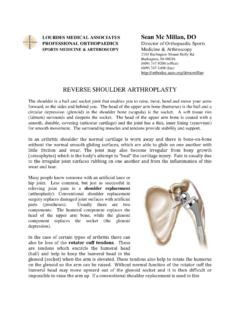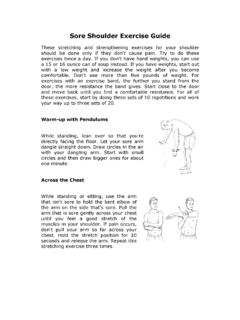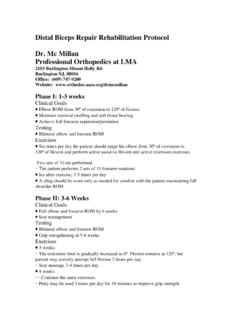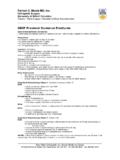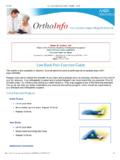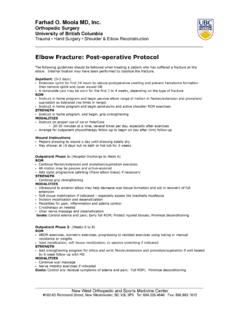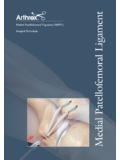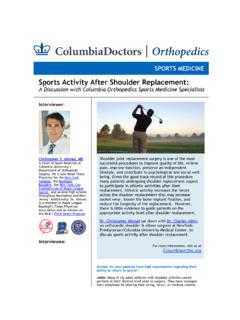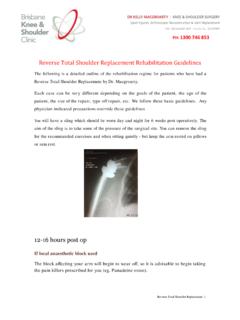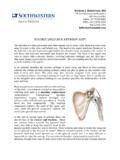Transcription of REVERSESHOULDER!ARTHROPLASTY!
1 MGH Sports Medicine Center 175 Cambridge St., 4th floor Boston, MA 02114 REVERSE shoulder ARTHROPLASTY The shoulder is a ball and socket joint that enables you to raise, twist, bend and move your arms forward, to the sides and behind you. The head of the upper arm bone (humerus) is the ball and a circular depression (glenoid) in the shoulder bone (scapula) is the socket.
2 A soft tissue rim (labrum) surrounds and deepens the socket. The head of the upper arm bone is coated with a smooth, durable, covering (articular cartilage) and the joint has a thin, inner lining (synovium) for smooth movement. The surrounding muscles and tendons provide stability and support. In an arthritic shoulder the normal cartilage is worn away and there is bone- on- bone without the normal smooth gliding surfaces which are able to glide on one another with little friction and wear.
3 The joint may also become irregular from bony growth (osteophytes) which is the body s attempt to heal the cartilage injury. Pain is usually due to the irregular joint surfaces rubbing on one another and from the inflammation of this wear and tear. Many people know someone with an artificial knee or hip joint. Less common, but just as successful in relieving joint pain is a shoulder replacement (arthroplasty).
4 Conventional shoulder replacement surgery replaces damaged joint surfaces with artificial parts (prostheses). Usually there are two components: The humeral component replaces the head of the upper arm bone, while the glenoid component replaces the socket (the glenoid depression). In the case of certain types of arthritis there can also be loss of the rotator cuff tendons. These are tendons which encircle the humeral head (ball) and help to keep the humeral head in the glenoid (socket) when the arm is elevated.
5 These tendons also help to rotate the humerus on the glenoid so the arm can be raised. Without normal function of the rotator cuff the humeral head may move upward out of the glenoid socket and it is then difficult or impossible to raise the arm up. If a conventional shoulder replacement is used in this REHABILITATION AFTER REVERSE shoulder ARTHROPLASTY situation, though there may be some pain relief, the humeral head usually remains upward out of the socket, and elevation of the arm is impossible.
6 The Inverse shoulder Replacement changes the orientation of the shoulder so that the normal socket (glenoid) now is replaced with an artificial ball, and the normal ball is replaced with an implant that has a socket into which the artificial ball rests. This type of replacement corrects the arthritis by replacing the worn out joint surfaces with an artificial joint made of metal (cobalt chrome) and plastic (polyethylene).
7 Reversing the ball and socket changes the mechanics of the shoulder in order to improve active range of motion and strength. This is because the force of the deltoid is increased by moving the center of rotation of the joint inward (medially) and downward (inferiorly). The result is the patient can raise his or her arm higher and sometimes even overhead. This shoulder implant has been used in Europe for nearly 15 years.
8 While the experience there has been very successful, complications have been reported. Most patients report minimal or no pain after surgery and most are able to raise the arm much higher than before surgery. The complication rate, however, is about 20%. Complications can include the following: Infection Instability of the joint replacement Fracture of either the humerus or glenoid bone Nerve injury Loosening of the joint replacement Anesthesia problems Hematoma or blood clots Postoperative Instructions You will wake up in the operating room with a sling in place.
9 You will go to the recovery room and then to a hospital room after a few hours. You can get out of bed when you wish. You should continue to apply ice to your shoulder to reduce pain and swelling. Pain is usually controlled for the first 18- 24 hours with a nerve block, which will be explained further by your anesthesiologist prior to surgery. Should you elect not to have a nerve block pain will be controlled via intravenous narcotic medications through a patient controlled anesthesia (PCA) machine.
10 This machine delivers the pain medication to you when you push a button. Afterwards you will be transitioned to an oral pain medications such as oxycodone. REHABILITATION AFTER REVERSE shoulder ARTHROPLASTY While a blood transfusion is rare, it is occasionally necessary. You may discuss donating your own blood in advance so it can be given to you should you require a transfusion after surgery.
